Are you thinking of starting your own chicken flock? If so, you should definitely consider the Leghorn chicken! Leghorns are a popular breed that are known for their striking appearance, high egg production, and feisty personalities.
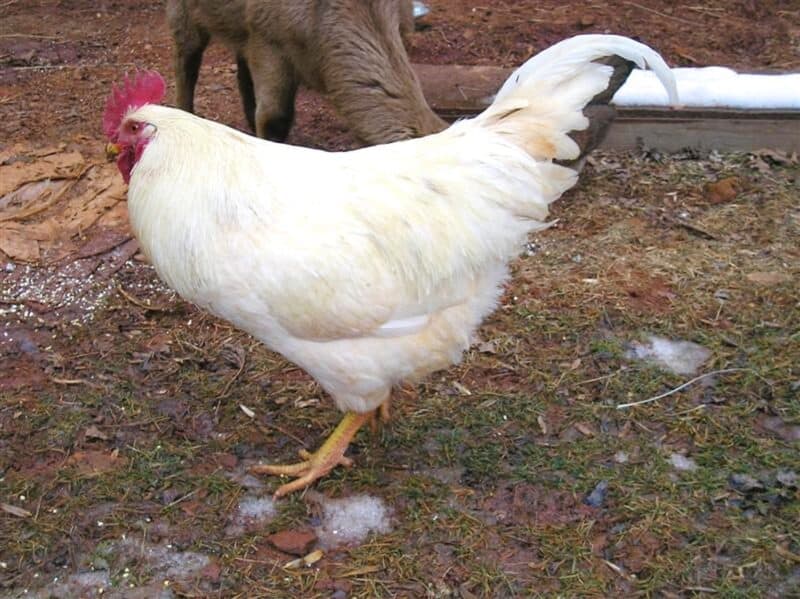
And yes, they’re the inspiration for the legendary Looney Tunes character Foghorn Leghorn – so they have that going for them, too.
If you’re curious about everything Leghorn chickens have to offer your backyard flock, you’re in the right place.
In this post, I’ll tell you everything you need to know about this classic (and quintessential) egg-laying chicken breed.
Table of Contents:
What is Leghorn Chicken?
If you are a beginner or a seasoned chicken keeper that loves to have fresh eggs, then Leghorn chickens are the perfect breed for you.
They are low maintenance, active, and can be socialized with humans and other birds with ease.
Leghorns are intelligent birds and easy to train, so making them a part of your family will be a piece of cake.
They’re also hardy, and can tolerate both cold winters and hot summers alike, so no need to worry about climate issues.
These white birds are raised predominantly for eggs, and are known as a lightweight breed requiring minimal inputs in terms of feed and space, but requires maximum outputs in the form of lots of delicious eggs.
Let’s take a closer look at the unique traits of the Leghorn chicken and what it can offer your backyard flock.
What is the History of Leghorn Chickens?
The Leghorn chicken originated in Italy and was known as a “Livorno” chicken in the 1800s. They were brought to the United States in the 1820s as an ornamental breed.
However, American farmers realized that these birds had a tremendous productivity when it came to egg-laying.
This led to their popularization and the development of the “American” Leghorn breed.
The American Leghorn breed was developed to lay as many eggs as possible. The industry required a hen that was more pragmatic in terms of egg-laying as compared to the ornamental qualities that were first imported.
This breed is a light-bodied chicken that can lay up to 320 eggs per year. This makes them one of the most productive breeds.
During the early 1900s, the Leghorn chicken was under attack by critics who claimed that the breed was frail and had little meat on their bones.
In what was called “The Great White Hope,” people started looking for breeds that would lead to better dinner tables.
This phase of hyping up meat breeds was the start of the end to the purebred and high-performance Leghorn varieties.
In the 1940s, the demand for Leghorns boomed tremendously. This was due to the need for high egg production during the wartime era.
American farmers had to provide more and more eggs for the families of soldiers who went to the war.
Leghorns were also most equipped to handle the hot and humid climate of the South… so, they thrived in that part of the country.
What Are Leghorn Chickens Good For?
Leghorns are some of the most prolific layers in the chicken world, known for producing upwards of 280-320 white eggs per year. That’s almost an egg a day!
This makes them a popular choice for commercial egg producers, who prize them for their efficiency and reliability when it comes to laying.
But even backyard chicken keepers can benefit from having a Leghorn or two in their flock, since they’ll provide plenty of eggs for their daily breakfast needs.
Leghorns have historically been used for their meat. However, this is less common today, as they tend to be on the leaner side and don’t have as much meat on their bones as other breeds.
That being said, Leghorn roosters can still be used for meat if desired. In fact, some people prefer their leaner, slightly tougher meat for dishes like chicken soup or curry.
Leghorns have also been used as show birds for many years. While they may not have the fancy feathers and fluffy personalities of some breeds, their sleek, clean appearance and high energy make them a popular choice for exhibitions.
Leghorn shows often feature categories for both white and brown Leghorns, as well as different variety categories (such as rose comb or single comb).
If you’re interested in getting involved in poultry shows, a Leghorn might be a good place to start!
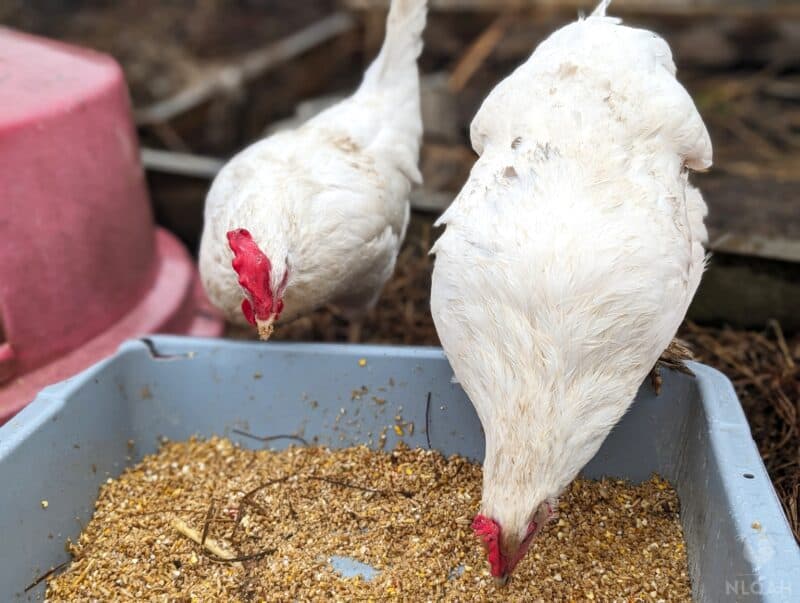
What Do They Look Like?
These birds are known for their egg-laying abilities but also possess a striking appearance. So, what do Leghorn chickens look like?
Size and Weight of Leghorn Chickens
Leghorn chickens are considered a medium-sized breed, with roosters weighing around 6-7 lbs and hens around 4-5lbs.
They are thin and have a sleek, upright posture, which makes them look quite elegant. These birds are also known for their long and slender legs, adding to their overall attractive appearance.
What Colors Do Leghorn Chickens Come In?
Leghorn chickens come in various colors, including white, brown, and black. The most common color, though, is white.
The feathers of Leghorn chickens are sleek, smooth, and shiny, making their striking colors stand out even more.
The earlobes and wattles can be white, red, or brown, depending on the color of their feathers.
Egg Laying and Temperament
Known for their slender body structure and striking white feathers, these chickens are a classic sight in any farmyard.
They’re bold and active, with strong natural instincts to roam and explore. This breed descends from Mediterranean chickens, which are known for their ability to adapt to extreme temperatures and run around with ease.
Leghorns have inherited these traits, making them energetic and curious birds that love to peck and scratch at the ground.
They aren’t the most docile chickens, which might make them less desirable for first-time chicken owners who prefer quieter and more relaxed birds.
While some folks enjoy having a flock of obedient and submissive birds, Leghorns tend to have minds of their own.
They don’t take kindly to being bossed around or handled too much, which can cause them to become agitated or fearful.
This isn’t to say that Leghorns can’t be trained, but they may require more patience and consistency compared to other breeds.
In fact, their independent nature can sometimes work in their favor, as they’ll find ways to escape from predators or seek out their own food sources.
Here’s a funny story. A few years ago, my husband and I bought a dozen chickens from an online hatchery.
We were hoping to raise Rhode Island Red chickens, and as the chickens grew older and matured into their adult feathers, we noticed something odd about one of the birds.
She was totally white.
As she got older, we realized that she wasn’t a Rhode Island Red, but was instead a Leghorn.
She eventually developed a mind of her own and stayed away from the flock, busting out of the run every day to roam among the trees.
Within a few weeks of being on her own, she started roosting in the trees…and then one day, she disappeared entirely.
She really did have a mind of her own – and while I’m pretty sure she ended up being caught by a fox, we were happy to let her be a free-range chicken, since she didn’t get along well with the other birds.
Chickens, sadly, tend to discriminate against birds that look a bit different. They could use some diversity training for sure!
Are Leghorns Good Egg Layers?
Definitely! Leghorns are known for their outstanding ability to lay plenty of eggs. So, if you’re looking for chickens that can produce large quantities of white eggs each day, Leghorns might be a great choice…
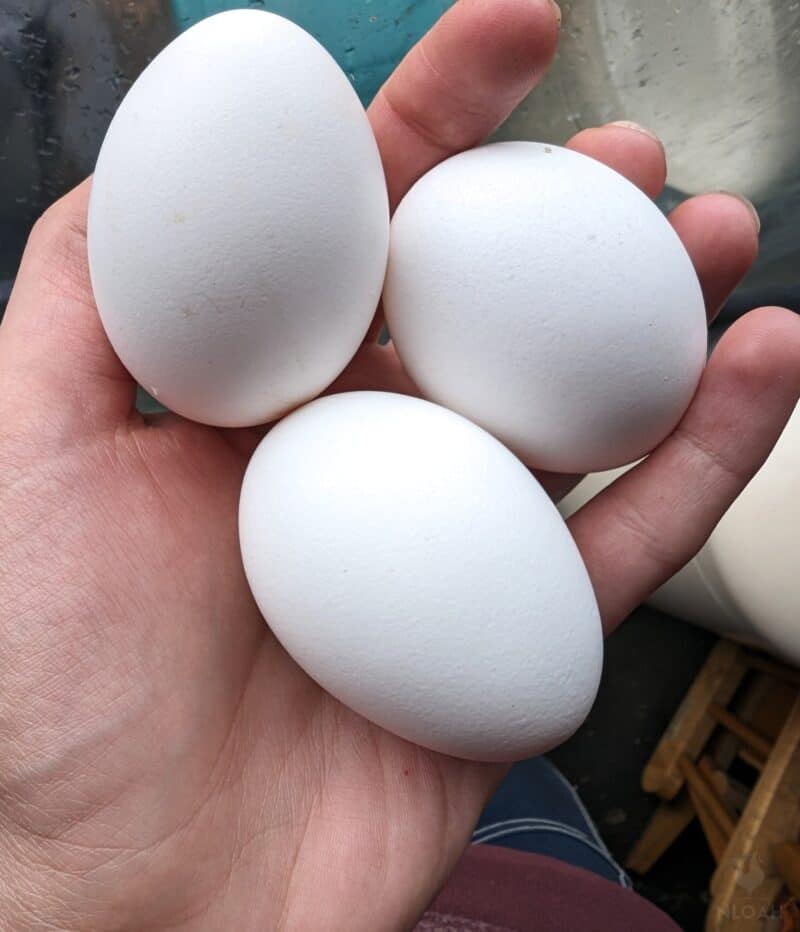
What Color Eggs Do Leghorns Lay?
The eggs of Leghorns are white in color. While other breeds like Ameraucanas and Marans lay eggs of different shades, Leghorns produce white eggs consistently.
The color of the egg doesn’t affect its nutritional value, but some egg consumers prefer a specific egg color over others.
When Do Leghorns Start Laying?
Leghorns are early-maturing birds when compared to other breeds. They start laying eggs when they are about five months old, and they typically reach maturity earlier than other breeds.
So, if you’re looking for chickens that start laying eggs early, then Leghorns might be the perfect choice.
How Long Do Leghorns Lay Eggs For?
Leghorns usually lay eggs for two to three years or even more, depending on their care and genetics.
After that, their egg production reduces, getting less and less each year as they go through the annual process called molting.
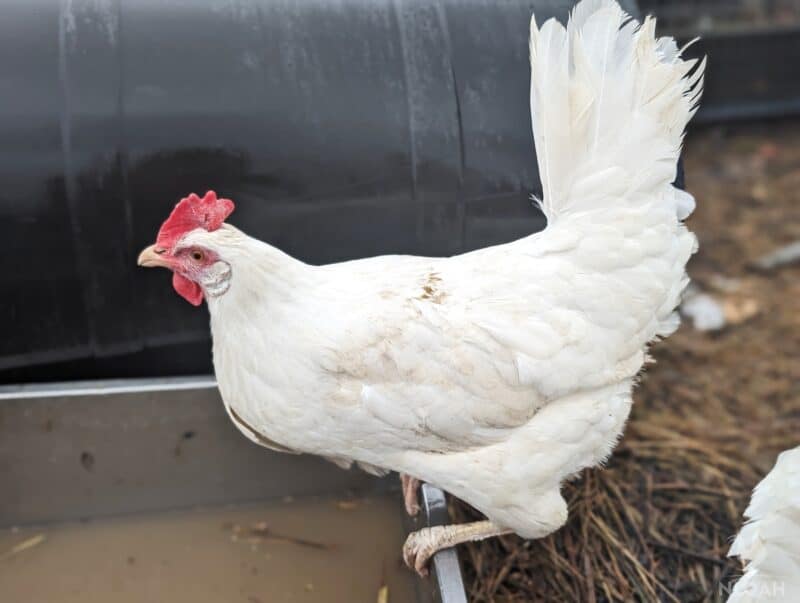
Can You Raise Leghorns for Meat?
There’s a common misconception that Leghorns aren’t suitable for meat because they’re smaller and leaner compared to other breeds.
However, while it’s true that Leghorns are generally not bred for meat production, this doesn’t necessarily mean they can’t be raised for meat.
Leghorns are still chickens, and like other breeds, they have meat on their bones. It just means you’ll have to manage their growth and diet carefully to ensure they reach a good size for butchering.
If you decide to raise Leghorns for meat, you’ll need to adjust their diet to include more protein and fat than you would for egg-laying Leghorns.
Be prepared to allow them to reach a mature size before butchering. Don’t rush the process; give your birds time to put on weight and build muscle.
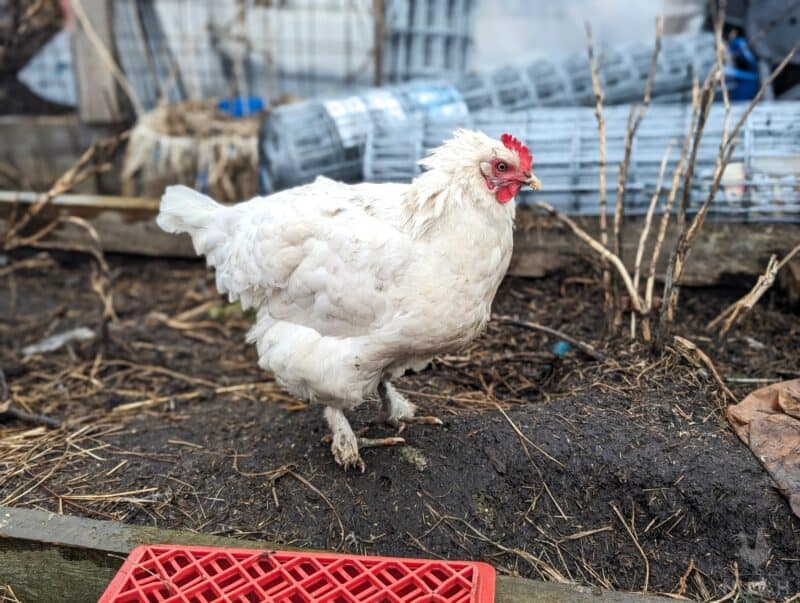
Tips to Help You Better Take Care of Them
There are some important things you need to know to help you care for Leghorn chickens.
What Do Leghorn Chickens Eat? Feeding and Nutritional Needs
Leghorn chickens are known for their voracious appetites and ability to forage for their own food.
However, to ensure that your birds are healthy and laying plenty of eggs, you need to provide them with a balanced, nutritious diet.
Leghorns need a feed that’s high in protein, usually around 20%, and they also require calcium for egg production.
You should provide them with a mix of grains, such as wheat, barley, and corn, as well as a layer feed that includes added vitamins and minerals.
You can also supplement their diet with kitchen scraps, such as cooked oatmeal, fruits, and vegetables, but avoid feeding them anything that’s high in salt.
Spacing in the Coop and Run
Leghorns are active birds that need plenty of room to move around. A good rule of thumb is to provide at least 4 square feet of space per bird in their coop.
If possible, give them access to a fenced-in area where they can stretch their wings and forage for bugs.
Keep in mind, Leghorns are known to be flighty, so it’s a good idea to clip their wings or provide a covered run.
Health Concerns and Predators
One common health concern for Leghorn chickens is respiratory issues, such as bronchitis, caused by damp, cold environments.
To prevent this, ensure that your coop is well-ventilated, dry, and draft-free.
Other health concerns include mites, lice, and parasites. You should perform regular checks on your birds and their living environment to prevent an infestation.
Cleanliness is key when it comes to keeping your birds healthy and productive!
As for predators, Leghorns are susceptible to a wide variety of predators, such as foxes, raccoons, and hawks.
To protect them, build a sturdy, enclosed coop with a predator-proof fence around it. You can also use motion-activated lights and noise-making devices to scare predators away, which I’ve found to be effective.
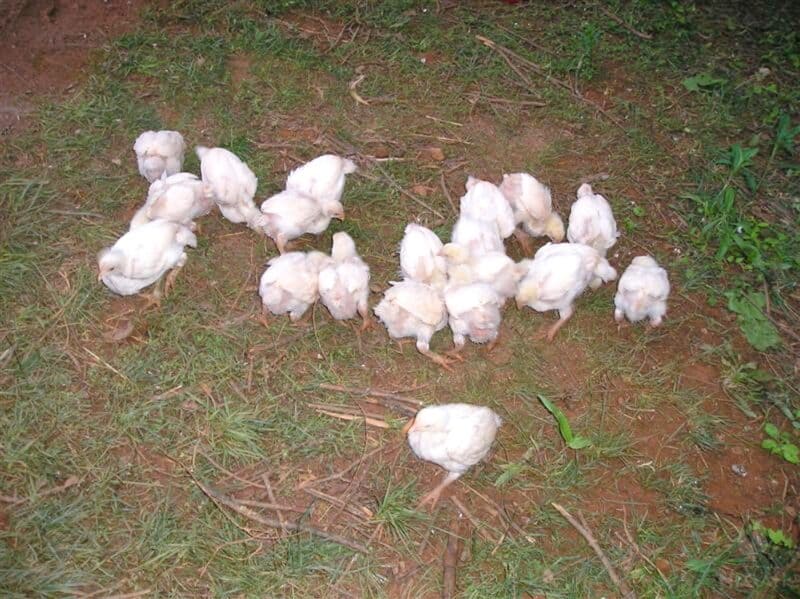
How Long Do Leghorn Chickens Live?
The lifespan of Leghorn chicken varies depending on the individual, the living arrangements, and their diet.
However, on average, a Leghorn chicken can live for up to 8 years. That’s right, you could have one of these birds in your flock for nearly a decade!
Is the Leghorn Right for You?
If you’re looking for a productive egg-laying chicken breed, the Leghorn is probably the right choice for you.
These birds lay far more eggs than chickens of other breeds, which is why they’ve been used in commercial settings for decades…
Whether you’re looking to get enough eggs for your own family or you want to have enough to sell or trade, Leghorn chickens are great options for you.
That said, Leghorns are notoriously noisy birds. They tend to be vocal throughout the day, which can be a problem for those living in close proximity to neighbors.
They also tend to be more flighty than other breeds, which can make them harder to handle.
If you’re looking for a chicken strictly to be raised as a pet, you may have a harder time with the Leghorn. These birds aren’t fond of being around people and don’t like being coddled.
Ultimately, it’s up to you to decide if the pros outweigh the cons, and if the unique personalities and characteristics of the Leghorn are right for you.
Whether you’re an experienced chicken owner or just starting out, the Leghorn is a breed worth considering (and one that would make ol’ Foghorn proud!).
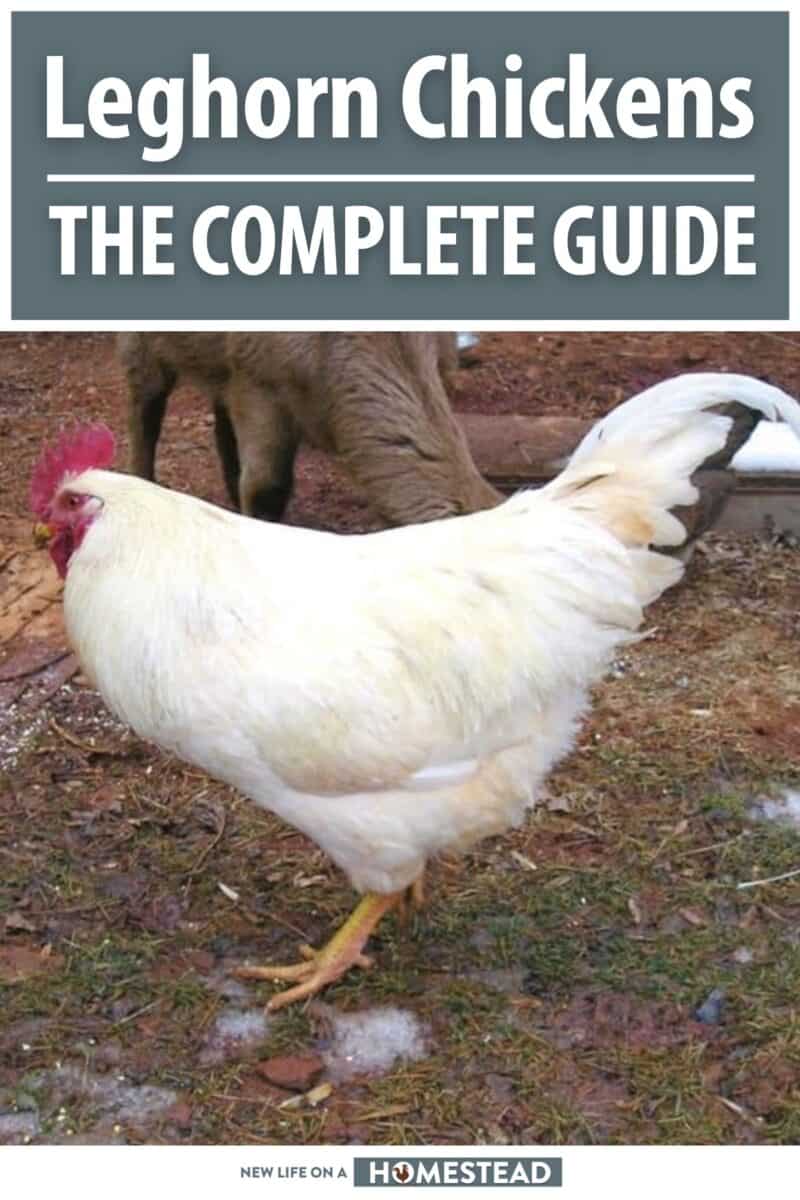

Rebekah is a high-school English teacher n New York, where she lives on a 22 acre homestead. She raises and grows chickens, bees, and veggies such as zucchini (among other things).
